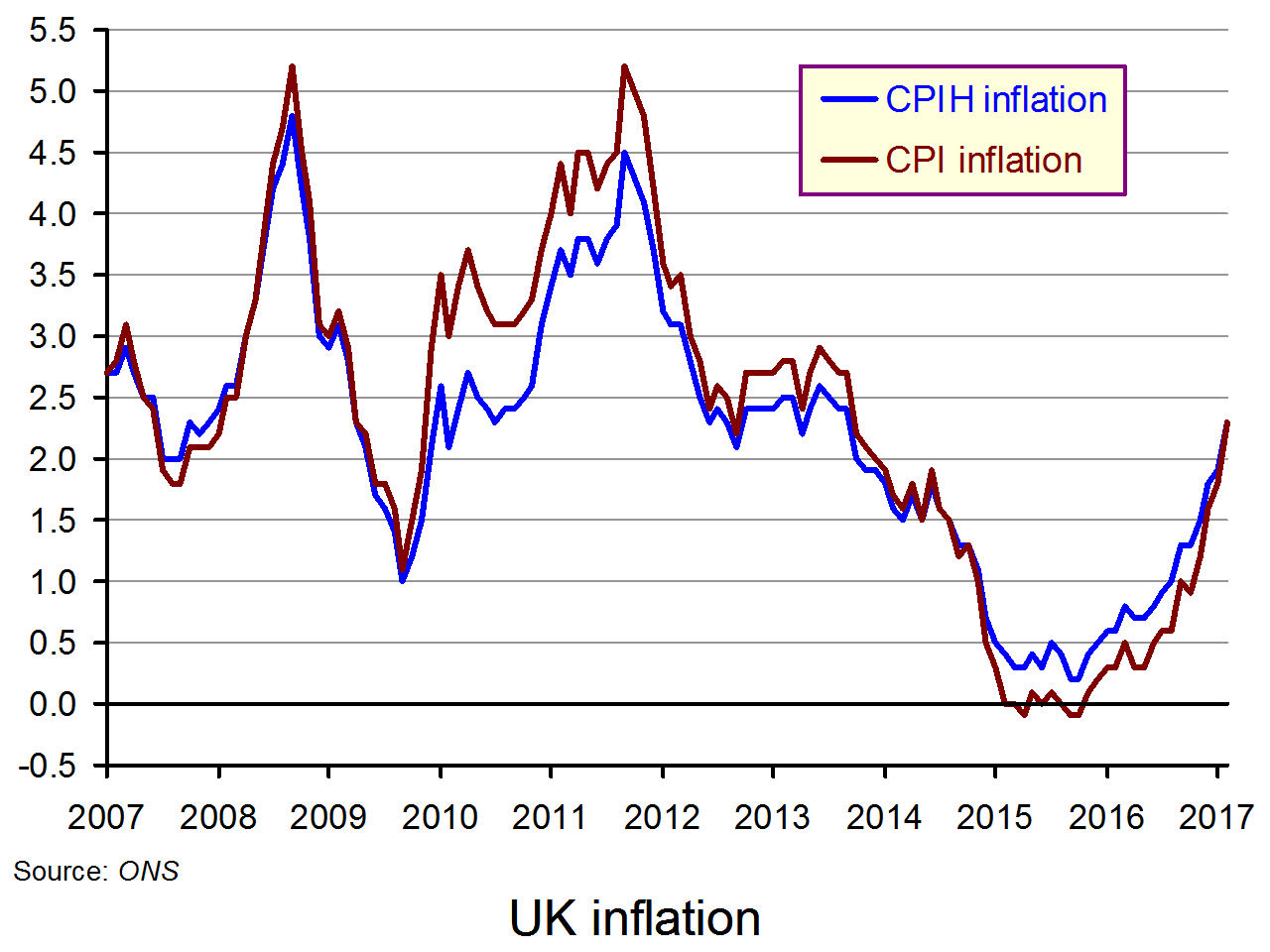 According to Christine Lagarde, Managing Director of the IMF, the slow growth in global productivity is acting as a brake on the growth in potential income and is thus holding back the growth in living standards. In a recent speech in Washington she said that:
According to Christine Lagarde, Managing Director of the IMF, the slow growth in global productivity is acting as a brake on the growth in potential income and is thus holding back the growth in living standards. In a recent speech in Washington she said that:
Over the past decade, there have been sharp slowdowns in measured output per worker and total factor productivity – which can be seen as a measure of innovation. In advanced economies, for example, productivity growth has dropped to 0.3 per cent, down from a pre-crisis average of about 1 per cent. This trend has also affected many emerging and developing countries, including China.
We estimate that, if total factor productivity growth had followed its pre-crisis trend, overall GDP in advanced economies would be about 5 percent higher today. That would be the equivalent of adding another Japan – and more – to the global economy.
So why has productivity growth slowed to well below pre-crisis rates? One reason is an ageing working population, with older workers acquiring new skills less quickly. A second is the slowdown in world trade and, with it, the competitive pressure for firms to invest in the latest technologies.
 A third is the continuing effect of the financial crisis, with many highly indebted firms forced to make deep cuts in investment and many others being cautious about innovating. The crisis has dampened risk taking – a key component of innovation.
A third is the continuing effect of the financial crisis, with many highly indebted firms forced to make deep cuts in investment and many others being cautious about innovating. The crisis has dampened risk taking – a key component of innovation.
What is clear, said Lagarde, is that more innovation is needed to restore productivity growth. But markets alone cannot achieve this, as the benefits of invention and innovation are, to some extent, public goods. They have considerable positive externalities.
She thus called on governments to give high priority to stimulating productivity growth and unleashing entrepreneurial energy. There are several things governments can do. These include market-orientated supply-side policies, such as removing unnecessary barriers to competition, driving forward international free trade and cutting red tape. They also include direct intervention through greater investment in  education and training, infrastructure and public-sector R&D. They also include giving subsidies and/or tax relief for private-sector R&D.
education and training, infrastructure and public-sector R&D. They also include giving subsidies and/or tax relief for private-sector R&D.
Banks too have a role in chanelling finance away from low-productivity firms and towards ‘young and vibrant companies’.
It is important to recognise, she concluded, that innovation and structural change can lead to some people losing out, with job losses, low wages and social deprivation. Support should be given to such people through better education, retraining and employment incentives.
Articles
IMF chief warns slowing productivity risks living standards drop Reuters, David Lawder (3/4/17)
Global productivity slowdown risks social turmoil, IMF warns Financial Times, Shawn Donnan (3/4/17)
Global productivity slowdown risks creating instability, warns IMF The Guardian, Katie Allen (3/4/17)
The Guardian view on productivity: Britain must solve the puzzle The Guardian (9/4/17)
Speech
Reinvigorating Productivity Growth IMF Speeches, Christine Lagarde, Managing Director, IMF(3/4/17)
Paper
Gone with the Headwinds: Global Productivity IMF Staff Discussion Note, Gustavo Adler, Romain Duval, Davide Furceri, Sinem Kiliç Çelik, Ksenia Koloskova and Marcos Poplawski-Ribeiro (April 2017)
Questions
- What is the relationship between actual and potential economic growth?
- Distinguish between labour productivity and total factor productivity.
- Why has total factor productivity growth been considerably slower since the financial crisis than before?
- Is sustained productivity growth (a) a necessary and/or (b) a sufficient condition for a sustained growth in living standards?
- Give some examples of technological developments that could feed through into significant growth in productivity.
- What is the relationship between immigration and productivity growth?
- What policies would you advocate for increasing productivity? Explain why.
 The term ‘Google it’ is now part of everyday language. If there is ever something you don’t know, the quickest, easiest, most cost-effective and often the best way to find the answer is to go to Google. While there are many other search engines that provide similar functions and similar results, Google was revolutionary as a search engine and as a business model.
The term ‘Google it’ is now part of everyday language. If there is ever something you don’t know, the quickest, easiest, most cost-effective and often the best way to find the answer is to go to Google. While there are many other search engines that provide similar functions and similar results, Google was revolutionary as a search engine and as a business model.
This article by Tim Harford, writing for BBC News, looks at the development of Google as a business and as a search engine. One of the reasons why Google is so effective for individuals and businesses is the speed with which information can be obtained. It is therefore used extensively to search key terms and this is one of the ways Google was able to raise advertising revenue. The business model developed to raise finance has therefore been a contributing factor to the decline in newspaper advertising revenue.
Google began the revolution in terms of search of engines and, while others do exist, Google is a classic example of a dominant firm and that raises certain problems. The article looks at many aspects of Google.
Just google it: The student project that changed the world BBC News, Tim Harford (27/03/17)
Questions
- Is Google a natural monopoly? What are the characteristics of a natural monopoly and how does this differ from a monopoly?
- Are there barriers to entry in the market in which Google operates?
- What are the key determinants of demand for Google from businesses and individuals?
- Why do companies want to advertise via Google? How might the reasons differ from advertising in newspapers?
- Why has there been a decline in advertising in newspapers? How do you think this has affected newspapers’ revenue and profits?
 Price fixing agreements between firms are one of the most serious breaches of competition law. Therefore, if detected, the firms involved face substantial fines (see here for an example), plus there is also the potential for jail sentences and director disqualification for participants. However, due to their secretive nature and the need for hard evidence of communication between firms, it is difficult for competition authorities to detect cartel activity.
Price fixing agreements between firms are one of the most serious breaches of competition law. Therefore, if detected, the firms involved face substantial fines (see here for an example), plus there is also the potential for jail sentences and director disqualification for participants. However, due to their secretive nature and the need for hard evidence of communication between firms, it is difficult for competition authorities to detect cartel activity.
In order to assist detection, competition authorities offer leniency programmes that guarantee full immunity from fines to the first participant to come forward and blow the whistle on the cartel. This has become a key way in which competition authorities detect cartels. Recently, competition authorities have introduced a number of new tools to try to enhance cartel detection.
 First, the European Commission launched an online tool to make it easier for cartels to be reported to them. This tool allows anonymous two-way communication in the form of text messages between a whistle blower and the Commission. The Commissioner in charge of competition policy, Margrethe Vestager, stated that:
First, the European Commission launched an online tool to make it easier for cartels to be reported to them. This tool allows anonymous two-way communication in the form of text messages between a whistle blower and the Commission. The Commissioner in charge of competition policy, Margrethe Vestager, stated that:
If people are concerned by business practices that they think are wrong, they can help put things right. Inside knowledge can be a powerful tool to help the Commission uncover cartels and other anti-competitive practices. With our new tool it is possible to provide information, while maintaining anonymity. Information can contribute to the success of our investigations quickly and more efficiently to the benefit of consumers and the EU’s economy as a whole.
 Second, the UK Competition and Markets Authority (CMA) has launched an online and social media campaign to raise awareness of what is illegal under competition law and to encourage illegal activity to be reported to them. The CMA stated that:
Second, the UK Competition and Markets Authority (CMA) has launched an online and social media campaign to raise awareness of what is illegal under competition law and to encourage illegal activity to be reported to them. The CMA stated that:
Cartels are both harmful and illegal, and the consequences of breaking the law are extremely serious. That is why we are launching this campaign – to help people understand what cartel activity looks like and how to report it so we can take action.
This campaign is on the back of the CMA’s own research which found that less that 25% of the businesses they surveyed believed that they knew competition law well. Furthermore, the CMA is now offering a reward of up to £100,000 and guaranteed anonymity to individuals who provide them with information.
It will be fascinating to see the extent to which these new tools are used and whether they aid the competition authorities in detecting and prosecuting cartel behaviour.
Articles
Questions
- Why do you think leniency programmes are a key way in which competition authorities detect cartels?
- Who do you think is most likely to blow the whistle on a cartel (see the article above by A.Stephan)?
- Why is it worrying that so few businesses appear to know competition law well?
- Which of the two tools do you think is most likely to enhance cartel detection? Explain why.
 The UK Parliament’s Culture Media and Sport Select Committee has been examining the secondary ticketing market. The secondary market for events is dominated by four agencies – viagogo, eBay-owned StubHub and Ticket-master’s Get Me In! and Seatwave. These buy tickets to events in the primary market (i.e. from the events or their agents) and then resell them, normally at considerably inflated prices to people unable to get tickets in the primary market.
The UK Parliament’s Culture Media and Sport Select Committee has been examining the secondary ticketing market. The secondary market for events is dominated by four agencies – viagogo, eBay-owned StubHub and Ticket-master’s Get Me In! and Seatwave. These buy tickets to events in the primary market (i.e. from the events or their agents) and then resell them, normally at considerably inflated prices to people unable to get tickets in the primary market.
One example has grabbed the headlines recently. This is where viagogo was advertising tickets for an Ed Sheeran charity concert for £5000. The original tickets were sold for between £40 and £110, with the money going to the Teenage Cancer Trust. None of viagogo’s profits would go to the charity. The tickets were marked ‘not for resale’; so there was doubt that anyone buying a ticket from viagogo would even be able to get into the concert!
There are four major issues.
 The first is that the tickets are often sold, as in the case of the Ed Sheeran concert, at many times their face value. We examined this issue back in September 2016 in the blog What the market will bear? Secondary markets and ticket touts).
The first is that the tickets are often sold, as in the case of the Ed Sheeran concert, at many times their face value. We examined this issue back in September 2016 in the blog What the market will bear? Secondary markets and ticket touts).
The second is that the secondary sites use ‘bots’ to buy tickets in bulk when they first come on sale. This makes it much harder for customers to buy tickets on the primary site. Often all the tickets are sold within seconds of coming on sale.
The third is whether the tickets sold on the secondary market are legitimate. Some, like the Ed Sheeran tickets, are marked ‘not for resale’; some are paperless and yet the secondary ticket agencies are accused of selling paper versions, which are worthless.
The fourth is that multiple seats that are listed together are not always located together and so people attending with friends or partners may be forced to sit separately.
These are the issues that were addressed by the Culture Media and Sport committee at its meeting on 21 March. It was due to take evidence from various people, including viagogo, the agency which has come in for the most criticism. Viagogo, however, decided not to attend. This has drawn withering criticism from the press and on social media. One of the other witnesses at the meeting, Keith Kenny, sales and ticketing director for the West End musical Hamilton, described viagogo as ‘a blot on the landscape’. He said, ‘Ultimately, our terms and conditions say ticket reselling is forbidden. If you look at the way that glossy, sneaky site is constructed, they’ve gone an awful long way not to be compliant in the way they’ve built their site.’
 The Competition and Markets Authority launched an enforcement investigation last December into suspected breaches of consumer protection law in the online secondary tickets market. This follows on from an earlier report for the government by an independent review chaired by Professor Waterson.
The Competition and Markets Authority launched an enforcement investigation last December into suspected breaches of consumer protection law in the online secondary tickets market. This follows on from an earlier report for the government by an independent review chaired by Professor Waterson.
The government itself is considering amending the Digital Economy Bill to make it illegal to use bots to buy tickets in excess of the limit set by the event. Online touts who break this new law would face unlimited fines.
Articles
- Touts to face unlimited fines for bulk-buying tickets online
Independent, Roisin O’Connor (13/3/17)
- Unlimited fines for bulk buying ticket touts
BBC News (11/3/17)
- Ticket touts face unlimited fines for using ‘bots’ to buy in bulk
The Guardian, Rob Davies (10/3/17)
- Ticket touts face unlimited fines in government crackdown on bots
Music Week, James Hanley (11/3/17)
- Government confirms bots ban and better enforcement in response to secondary ticketing review
CMU, Chris Cooke (13/3/17)
- The ‘Viagogo Glitch’: Why Fans Must Be Put First In The Secondary Ticketing Market
Huffington Post, Sharon Hodgson (14/3/17)
- Angry MPs accuse no-show Viagogo of ‘fraudulent mis-selling’ of Ed Sheeran tickets
i News, Adam Sherwin (21/3/17)
 Ed Sheeran’s manager Stuart Camp on secondary ticketing
Ed Sheeran’s manager Stuart Camp on secondary ticketingBBC News, Stuart Camp (21/3/17)
- Fury at Viagogo no-show as MPs probe tickets on sale for thousands
Coventry Telegraph, James Rodger (22/3/17)
- Music fans given 10-step guide on how to tackle ticket touts
Daily Record, Mark McGivern (20/3/17)
 Viagogo snubs MPs’ inquiry into online ticket reselling
Viagogo snubs MPs’ inquiry into online ticket resellingThe Guardian, Rob Davies (21/3/17)
- Viagogo a No-Show at U.K. Hearing Into Secondary Ticketing: ‘Huge Lack of Respect’
Billboard, Richard Smirke (21/3/17)
 Daily Record campaign against ticket touts reaches Parliament but Viagogo don’t show up to answer claims
Daily Record campaign against ticket touts reaches Parliament but Viagogo don’t show up to answer claimsDaily Record, Torcuil Crichton and Keith McLeod (22/3/17)
- Ticketmaster is using its software — and your data — to take on ticket-buying bots
recode, Peter Kafka (14/3/17)
Official sites and documents
Questions
- Use a demand and supply diagram to demonstrate how secondary ticket agencies are able to sell tickets for popular events at prices several times the tickets’ face value.
- If secondary ticket sites and ticket touts are able to sell tickets at well above box office prices, isn’t this simply a reflection of people’s willingness to pay (i.e. their marginal utility)? In which case, aren’t these sellers providing a useful service?
- How do secondary ticket agencies reduce consumer surplus? Could they reduce it to zero?
- See Tickets, the primary market ticket agency, has set up a secondary site, whereby fans can trade tickets with one another at a mark-up capped at just 5%. Will this help to reduce abuses on the secondary market, or is it a totally separate part of the market?
- Would it be a good idea for event organisers to charge higher prices for popular events than they do at present, but still below the equilibrium?
- How does the price elasticity of demand influence the mark-up that secondary ticket agencies can make? Illustrate this on a diagram similar to the one in question 1.
- What measures would you advocate to make tickets more available to the public at reasonable prices? Explain their benefits and any drawbacks.
- What would be the effect on prices if the use of bots could be successfully banned?
 The latest figures from the ONS show that UK inflation rose to 2.3% for the 12 months to February 2017 – up from 1.9% for the 12 months to January. The rate is the highest since September 2013 and has steadily increased since late 2015.
The latest figures from the ONS show that UK inflation rose to 2.3% for the 12 months to February 2017 – up from 1.9% for the 12 months to January. The rate is the highest since September 2013 and has steadily increased since late 2015.
The main price index used to measure inflation is now CPIH, as opposed to CPI. CPIH is the consumer prices index (CPI) adjusted for housing costs and is thus a more realsitic measure of the cost pressures facing households. As the ONS states:
CPIH extends the consumer prices index (CPI) to include a measure of the costs associated with owning, maintaining and living in one’s own home, known as owner occupiers’ housing costs (OOH), along with Council Tax. Both of these are significant expenses for many households and are not included in the CPI.
But why has inflation risen so significantly? There are a number of reasons.
 The first is a rise in transport costs (contributing 0.15 percentage points to the overall inflation rate increase of 0.4 percentage points). Fuel prices rose especially rapidly, reflecting both the rise in the dollar price of oil and the depreciation of the pound. In February 2016 the oil price was $32.18; in February 2017 it was $54.87 – a rise of 70.5%. In February 2016 the exchange rate was £1 = $1.43; in February 2017 it was £1 = $1.25 – a depreciation of 12.6%.
The first is a rise in transport costs (contributing 0.15 percentage points to the overall inflation rate increase of 0.4 percentage points). Fuel prices rose especially rapidly, reflecting both the rise in the dollar price of oil and the depreciation of the pound. In February 2016 the oil price was $32.18; in February 2017 it was $54.87 – a rise of 70.5%. In February 2016 the exchange rate was £1 = $1.43; in February 2017 it was £1 = $1.25 – a depreciation of 12.6%.
The second biggest contributor to the rise in inflation was recreation and culture (contributing 0.08 percentage points). A wide range of items in this sector, including both goods and services, rose in price. ‘Notably, the price of personal computers (including laptops and tablets) increased by 2.3% between January 2017 and February 2017.’ Again, a large contributing factor has been the fall in the value of the pound. Apple, for example, raised its UK app store prices by a quarter in January, having raised prices for iPhones, iPads and Mac computers significantly last autumn. Microsoft has raised its prices by more than 20% this year for software services such as Office and Azure. Dell, HP and Tesla have also significantly raised their prices.
The third biggest was food and non-alcoholic beverages (contributing 0.06 percentage points). ‘Food prices, overall, rose by 0.8% between January 2017 and February 2017, compared with a smaller rise of 0.1% a year earlier.’ Part of the reason has been the fall in the pound, but part has been poor harvests in southern Europe putting up euro prices. This is the first time that overall food prices have risen for more than two-and-a-half years.
 It is expected that inflation will continue to rise over the coming months as the effect of the weaker pound and higher raw material and food prices filter though. The current set of pressures could see inflation peaking at around 3%. If there is a futher fall in the pound or further international price increases, inflation could be pushed higher still – well above the Bank of England’s 2% target. (Click here for a PowerPoint of the chart.)
It is expected that inflation will continue to rise over the coming months as the effect of the weaker pound and higher raw material and food prices filter though. The current set of pressures could see inflation peaking at around 3%. If there is a futher fall in the pound or further international price increases, inflation could be pushed higher still – well above the Bank of England’s 2% target. (Click here for a PowerPoint of the chart.)
The higher inflation means that firms are facing a squeeze on their profits from two directions.
First, wage rises have been slowing and are now on a level with consumer price rises. It is likely that wage rises will soon drop below price rises, meaning that real wages will fall, putting downward pressure on spending and squeezing firms’ revenue.
Second, input prices are rising faster than consumer prices. In the 12 months to February 2017, input prices (materials and fuels) rose by 19.1%, putting a squeeze on producers. Producer prices (‘factory gate prices’), by contrast, rose by 3.7%. Even though input prices are only part of the costs of production, the much smaller rise of 3.7% reflects the fact that producer’s margins have been squeezed. Retailers too are facing upward pressure on costs from this 3.7% rise in the prices of products they buy from producers.
One of the worries about the squeeze on real wages and the squeeze on profits is that this could dampen investment and slow both actual and potential growth.
 So will the Bank of England respond by raising interest rates? The answer is probably no – at least not for a few months. The reason is that the higher inflation is not the result of excess demand and the economy ‘overheating’. In other words, the higher inflation is not from demand-pull pressures. Instead, it is from higher costs, which are in themselves likely to dampen demand and contribute to a slowdown. Raising interest rates would cause the economy to slow further.
So will the Bank of England respond by raising interest rates? The answer is probably no – at least not for a few months. The reason is that the higher inflation is not the result of excess demand and the economy ‘overheating’. In other words, the higher inflation is not from demand-pull pressures. Instead, it is from higher costs, which are in themselves likely to dampen demand and contribute to a slowdown. Raising interest rates would cause the economy to slow further.
Videos
 UK inflation shoots above two percent, adding to Bank of England conundrum Reuters, William Schomberg, David Milliken and Richard Hunter (21/3/17)
UK inflation shoots above two percent, adding to Bank of England conundrum Reuters, William Schomberg, David Milliken and Richard Hunter (21/3/17)
 Bank target exceeded as inflation rate rises to 2.3% ITV News, Chris Choi (21/3/17)
Bank target exceeded as inflation rate rises to 2.3% ITV News, Chris Choi (21/3/17)
 Steep rise in inflation Channel 4 News, Siobhan Kennedy (21/3/17)
Steep rise in inflation Channel 4 News, Siobhan Kennedy (21/3/17)
 U.K. Inflation Gains More Than Forecast, Breaching BOE Goal Bloomberg, Dan Hanson and Fergal O’Brien (21/3/17)
U.K. Inflation Gains More Than Forecast, Breaching BOE Goal Bloomberg, Dan Hanson and Fergal O’Brien (21/3/17)
Articles
Inflation leaps in February raising prospect of interest rate rise The Telegraph, Julia Bradshaw (21/3/17)
Brexit latest: Inflation jumps to 2.3 per cent in February Independent, Ben Chu (21/3/17)
UK inflation rate leaps to 2.3% BBC News (21/3/17)
UK inflation: does it matter for your income, debts and savings? Financial Times, Chris Giles (21/3/17)
Rising food and fuel prices hoist UK inflation rate to 2.3% The Guardian, Katie Allen (21/3/17)
Reality Check: What’s this new measure of inflation? BBC News (21/3/17)
Data
UK consumer price inflation: Feb 2017 ONS Statistical Bulletin (21/3/17)
UK producer price inflation: Feb 2017 ONS Statistical Bulletin (21/3/17)
Inflation and price indices ONS datasets
Consumer Price Inflation time series dataset ONS datasets
Producer Price Index time series dataset ONS datasets
European Brent Spot Price US Energy Information Administration
Statistical Interactive Database – interest & exchange rates data Bank of England
Questions
- If pries rise by 10% and then stay at the higher level, what will happen to inflation (a) over the next 12 months; (b) in 13 months’ time?
- Distinguish between demand-pull and cost-push inflation. Why are they associated with different effects on output?
- If producers face rising costs, what determines their ability to pass them on to retailers?
- Why is the rate of real-wage increase falling, and why may it beome negative over the coming months?
- What categories of people are likely to lose the most from inflation?
- What is the Bank of England’s remit in terms of setting interest rates?
- What is likely to affect the sterling exchange rate over the coming months?
 According to Christine Lagarde, Managing Director of the IMF, the slow growth in global productivity is acting as a brake on the growth in potential income and is thus holding back the growth in living standards. In a recent speech in Washington she said that:
According to Christine Lagarde, Managing Director of the IMF, the slow growth in global productivity is acting as a brake on the growth in potential income and is thus holding back the growth in living standards. In a recent speech in Washington she said that: A third is the continuing effect of the financial crisis, with many highly indebted firms forced to make deep cuts in investment and many others being cautious about innovating. The crisis has dampened risk taking – a key component of innovation.
A third is the continuing effect of the financial crisis, with many highly indebted firms forced to make deep cuts in investment and many others being cautious about innovating. The crisis has dampened risk taking – a key component of innovation. education and training, infrastructure and public-sector R&D. They also include giving subsidies and/or tax relief for private-sector R&D.
education and training, infrastructure and public-sector R&D. They also include giving subsidies and/or tax relief for private-sector R&D.




 Price fixing agreements between firms are one of the most serious breaches of competition law. Therefore, if detected, the firms involved face substantial fines (see
Price fixing agreements between firms are one of the most serious breaches of competition law. Therefore, if detected, the firms involved face substantial fines (see 







